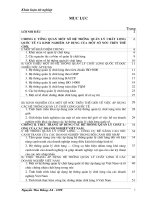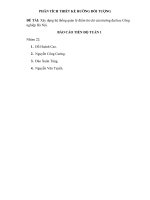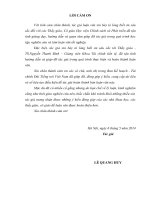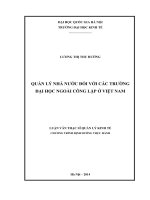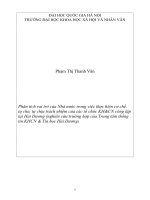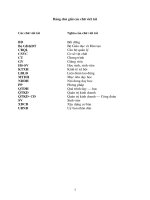Quản lý tài chính tại các trường đại học công lập trực thuộc bộ công thương trong điều kiện thực hiện cơ chế tự chủ tài chính tt tiếng anh
Bạn đang xem bản rút gọn của tài liệu. Xem và tải ngay bản đầy đủ của tài liệu tại đây (1009.63 KB, 30 trang )
MINISTRY OF EDUCATION AND TRAINING
MINISTRY OF
FINANCE
ACADEMY OF FINANCE
NGUYEN DONG ANH XUAN
FINANCIAL MANAGEMENT AT PUBLIC UNIVERSITIES
UNDER THE MINISTRY OF INDUSTRY AND TRADE IN
THE CONDITION OF IMPLEMENTING FINANCIAL
AUTONOMY MECHANISM
Major: Finance - Banking
Code: 9.34.02.01
SUMMARY OF ECONOMIC DOCTORAL THESIS
2. TS. Đỗ Thị Thanh Vân
HANOI - 2020
The work was completed at the Academy of Finance
Scientific instructors: Assoc.Prof., PhD. Tran Thi Ha
PhD. Do Thi Thanh Van
Reviewer 1:.......................................................................
Reviewer 2:.......................................................................
Reviewer 3:.......................................................................
The thesis will be defended in front of the
Academy-level Thesis Assessment Council meeting
at the Academy of Finance
At: .......... hour ....... date ........ month ...... 2020
The thesis can be found at National Library of Vietnam,
Academy of Finance.
1
INTRODUCTION
1. The urgency of the research topic
Throughout the course of history, our Party and State have always
affirmed the key role of education and training in general and higher
education in particular to the country's socio-economic development.
The Second Plenum of the Eighth Session (December 1996),
affirmed: “Truly considering education and training as the leading
national policies; Investment in education is an investment in
development”. In particular, Resolution No. 29-NQ/TW of the 8th
Plenum of the Eleventh Session (November 2013) “On basic and
comprehensive innovation in education and training, meeting the
requirements of industrialization and modernization in the conditions
of a socialist-oriented market economy and international integration”
has emphasized: “Education and training are the leading national
policies, the cause of the Party, the State and the entire people.
Investment in education is a development investment, with priority
given to socio-economic development programs and plans”.
The practice proves that finance is a very important factor affecting
the quality of higher education, because the financial source is the
basis for universities to invest in developing other resources such as
people and facilities. - The decisive factors to the quality of higher
education. However, State budget allocated to public universities for
regular expenditures and investment is still limited, non-business
income sources face the challenge of increasing competition in higher
education, which requires improving the efficiency of financial
management at public universities in Vietnam.
For public universities under the Ministry of Industry and Trade,
formerly known as long-standing worker training, intermediate, and
vocational schools in Vietnam which were upgraded from colleges to
2
universities in the period of 2004-2011. Therefore, the foundation of
undergraduate, postgraduate training, scientific research and university
administration experience in general, and financial management in
particular of many universities still have certain limitations in the
development process. Moreover, the implementation of the financial
autonomy mechanism under the Government's Resolution No.
77/2014/NQ-CP dated October 24th, 2014, on piloting the renovation of
operation mechanism for public higher education institutions in the
period of 2014-2017, Government’s Decree No. 16/2015/ND-CP dated
February 14th, 2015 stipulating the autonomy of public non-business
units, the Law on Amending and Supplementing a number of articles
of the Law on Higher Education dated November 19 th, 2018,
Government’s Decree No. 99/2019/ND-CP dated December 30 th, 2019
detailing and guiding the implementation of a number of articles of the
Law on Higher Education, which further imposes a need to improve
financial management at public universities under the Ministry of
Industry and Trade to enhance the mobilization and efficient use of
financial sources, especially non-State budget sources.
From the aforementioned issues, an urgent task is conducting a
basic and systematic research to find suitable solutions to improve
financial management at public universities under the Ministry of
Industry and Trade, promptly respond to the requirements of socioeconomic development in Vietnam and in line with the trend of
international economic integration. Therefore, the research of the topic
"Financial management at public universities under the Ministry of
Industry and Trade in the condition of implementing financial
autonomy mechanism" has meaning in both theory and practice.
2. Overview of research situation related to the thesis
a) Research situation in foreign countries
- Research on financial management in higher education:
3
Author Malcolm Prowolm & Eric Morgan (2005), "Financial
management and control for higher education". Research by Marianne,
C and Lesley, A (2000), "Financial management and resources in
education". Tsang, M.C. (1997), "Cost analysis to create and evaluate
better education policy". Besides, financial management research is
associated with specific higher education institutions, such as the
research of author Sulochana (1991), “Financial Management of
higher education in India - Case study of Osmania University”.
- Research on university autonomy: The practice shows that there
are many researches with different perspectives on university autonomy
depending on the level of development and awareness of each country
about the role of higher education. According to Berdahl, Graham and
Piper (1971), "university autonomy is the power of the University to
control its own operations without external control". According to Don
Anderson and Richard Johnson (1998), “university autonomy is the
freedom of a higher education institution to run its own businesses
without direction or influence from any level of government”.
b) Domestic research situation
- Research on financial management in higher education:
Author Dang Van Du (2004), "Solutions to improve the efficiency of
financial investment for higher education in Vietnam". The thesis of
author Le Phuoc Minh (2005), "Improvement of financial policies for
higher education in Vietnam". The thesis of author Bui Tien Hanh
(2006), "Improvement of financial mechanism to promote the
socialization of education in Vietnam". Research by Nguyen Anh Thai
(2008), "Improvement of financial management mechanism for
universities in Vietnam". Author Nguyen Thu Huong (2014),
"Improvement of financial management mechanism for high quality
training programs in Vietnamese public universities". The research is
quite "close" to the thesis topic of PhD students, including the thesis of
4
author Vu Thi Thanh Thuy (2012), "Financial management of public
universities in Vietnam". The research of author Nguyen Minh Tuan
(2015), "The impact of financial management on the quality of higher
education - Case studies at universities under the Ministry of Industry
and Trade". The thesis of author Truong Thi Hien (2017), "Financial
management at public universities under the Ministry of Education and
Training in Ho Chi Minh City in autonomy”.
In addition, there are ministerial-level topics of author Vu Duy Hao
(2005), "Improvement of financial management mechanism for public
universities of economic sectors in Vietnam". Ministry-level topic of
Pham Van Ngoc (2007), "Renovation of the financial management
mechanism of Vietnam National University, Hanoi to meet
development requirements till 2015 and vision to 2025".
- Research on financial autonomy in higher education: The research
of author Mai Ngoc Cuong (2008), "Financial autonomy in current public
universities in Vietnam". The thesis of author Tran Duc Can (2012),
"Improvement of financial autonomy mechanism in public universities in
Vietnam". The thesis of author Luong Van Hai (2011), "The role of the State
in expanding autonomy of Vietnamese public universities".
c) Research gaps
From the results of an overview of the research projects, the PhD
students found that there are many quite comprehensive research
projects on financial management in Vietnam and abroad, and issues
related to financial management in higher education. However, there
is no in-depth research of financial management in public universities
under the Ministry of Industry and Trade. This has resulted in
insufficient scientific grounds to propose solutions to improve
financial management in the condition of implementing university
autonomy in order to improve the efficiency of financial management
and the quality of higher education, specifically:
5
- The above-mentioned researches only focus on Vietnamese
public universities in general in the context that financial autonomy
mechanism is not comprehensive, public universities are heavily
dependent on the State budget; There are no in-depth researches on
financial management for the characteristics of public universities
under the Ministry of Industry and Trade, especially the context of
competition in higher education is becoming more and more
nowadays. Moreover, university autonomy has become an
indispensable development trend in the world, the Government
issued Resolution No. 77/2014/NQ-CP dated October 24 th, 2014 on
piloting the renovation of operation mechanism for public higher
education institutions in the period of 2014-2017, Decree No.
16/2015/ND-CP dated February 14th, 2015 stipulating the autonomy
of public non-business units, Law No. 34/2018/QH14 dated
November 9th, 2018 amending and supplementing a number of
articles of the Law on Higher Education.
- Researches on financial autonomy in particular and university
autonomy in general in Vietnam in recent years have focused on
researching and proposing macro solutions without many in-depth
researches to propose micro solutions associated with specific
conditions of public universities.
- In the current context, the State's mechanisms, policies and
regulations have had many changes with strong international
integration, some of the results and researches mentioned above are
no longer appropriate. Therefore, it is necessary to research to find a
solution that meets financial management requirements at public
universities under the Ministry of Industry and Trade in the condition
of implementing financial autonomy.
3. Research purpose
6
On the basis of researching and clarifying the basic theoretical
issues on financial autonomy, financial management in public
universities, the thesis surveyed, analyzed and assessed the situation
of financial management at public universities under the Ministry of
Industry and Trade, drawing out the achieved results, limitations and
causes, thereby serving as a basis for proposing solutions to improve
financial management at public universities under Ministry of
Industry and Trade in the condition of implementing financial
autonomy mechanism until 2025 with a vision to 2030 ”.
4. Research subject and scope
a) Research subject: Research on financial management issues at
public universities under financial autonomy.
b) Research scope
- Research content: The research on financial management,
financial management of public universities includes many
management contents, but within the scope of research of the thesis,
the author focuses on the management of revenues, expenditures, and
management of financial results at public universities in the condition
of implementing financial autonomy.
- Research space: The research on financial management at 05 (five)
typical universities for 09 (nine) public universities under the Ministry of
Industry and Trade, including Hanoi University of Industry and
Industrial University of Ho Chi Minh City, Ho Chi Minh City University
of Food Industry, Sao Do University, Quang Ninh University of
Industry; thereby generalizing the status of financial management at
public universities under the Ministry of Industry and Trade.
- Research period: Collecting data, analyzing financial
management status at public universities under the Ministry of
Industry and Trade mainly in the period of 2014-2018, proposing
solutions to 2025 with a vision to 2030.
7
5. Research method
a) Research metholody and methods
- Dialectical materialism and historical materialism are used in the
entire research process.
- Methods of analysis and synthesis are the key methods used in
the research process. In addition, the thesis uses statistical and
comparative methods.
b) Methods of data collection
- Statistics and synthesis: This method is used to collect data on
financial activities, personnel, facilities and learners at public
universities under the Ministry of Industry and Trade. Data sources of
the universities are collected, listed and synthesized from financial
statements, annual reports ... and from the results of interviews and
surveys at the relevant universities, ministries and branches.
- Interview with experts: This method is used to collect comments
and assessments of officials of relevant ministries and branches and
public servants and managers of universities to clarify research issues.
- Survey: Conducting surveys with 4 target groups: (i) Leaders of
some Departments of the Ministry of Industry and Trade; (ii)
University leaders; (iii) Head and deputy head of units of the
University; (iv) Lecturers and experts. The questionnaire is designed
based on the research contents of the thesis combined with 5-level
Likert scale (From 1 - Strongly disagree to 5 - Strongly agree).
- Data processing: The collected data is processed by quantitative
analysis software, data processing is to synthesize, analyze the data
and produce research results.
6. Scientific and practical significance of the research topic
Firstly, generalizing the researches related to the thesis topic,
analyzing and clarifying the research gaps of the thesis topic.
8
Secondly, the thesis systematizes and enriches a number of basic
theoretical issues on financial management at public universities in the
condition of implementing the financial autonomy mechanism such as
concept, characteristics and role of public universities; concepts,
objectives, content, tools and factors affecting financial management at
public universities in the condition of implementing financial autonomy.
Thirdly, the thesis summarizes financial management experience at
public universities of some countries in the world such as the United
States, Japan, and Korea to draw some lessons for Vietnam.
Fourth, the thesis generalizes public universities under the Ministry of
Industry and Trade; summarizes, analyzes, demonstrates and draws some
conclusions about the achieved results, limitations and causes of the state
of financial autonomy and financial management at public universities
under the Ministry of Industry and Trade in the period of 2014-2018.
Fifthly, the thesis presents the background, perspective and
orientation of public higher education development; proposes 06
solution groups with specific solutions and 04 proposal groups to
improve financial management at public universities under the Ministry
of Industry and Trade in the near future. The proposed solutions are
systematic, consistent with theoretical and practical basis.
7. Structure of the thesis
Chapter 1: Theoretical basis for financial management at public
universities in the condition of implementing financial autonomy.
Chapter 2: Current situation of financial management at public
universities under the Ministry of Industry and Trade in the condition
of implementing financial autonomy.
Chapter 3: Solutions to improve financial management at public
universities under the Ministry of Industry and Trade in the condition
of implementing financial autonomy mechanism.
9
CHAPTER 1: THEORETICAL BASIS FOR FINANCIAL
MANAGEMENT AT PUBLIC UNIVERSITIES IN THE
CONDITION OF IMPLEMENTING FINANCIAL AUTONOMY
1.1. Public universities in the higher education system
1.1.1. Concept of public universities
1.1.2. Characteristics of public universities
1.1.3. The role of public universities in the higher
education system
1.2. Financial management at public universities
1.2.1. Concept of financial management at public universities
Within the scope of the thesis, the concept of financial management at
public universities below is used as the basis for the research process.
"Financial management at public universities is the management of the
formation, use and distribution of financial resources through the
planning, organization, control, inspection and supervision of financial
activities under the financial management mechanism of the State to
ensure funding for the task performance of public universities"
1.2.2. The goal of financial management at public universities
- Strictly complying with the regulations of the State on financial management.
- Developing financial sources for the University's activities.
- Using effectively financial resources.
- Improving the effectiveness of financial inspection and supervision.
1.2.3. Contents of financial management at public universities
1.2.3.1. Management of revenue resources and levels
1.2.3.2. Management of the use of financial resources
1.2.3.3. Management of financial results for the year
and use of funds
1.2.3.4. Asset management
1.2.4. Financial management tool at public universities
10
- Financial policies of the State for public universities
- Financial plans of public universities
- Internal financial regulations of public universities
- Accounting regime applied at public universities
- Financial inspection and supervision
1.3. Financial autonomy mechanism and its impact on
financial management at public universities
1.3.1. Financial autonomy mechanism at public universities
1.3.1.1. Concept of financial autonomy mechanism
The financial autonomy mechanism for public universities is
understood as the mechanism for empowering public universities to make
decisions and take self-responsibility for financial activities, under which
public universities are empowered to make their own decisions, take selfresponsibility for revenue and expenditure and financial relations
according to the degree of autonomy decentralized by the State.
1.3.1.2. Contents of financial autonomy mechanism
- Autonomy mechanism on revenue sources and levels.
- Autonomy mechanism on the use of financial sources.
- Autonomy mechanism on the use of financial results
- Autonomy mechanism on asset management.
1.3.2. Impact of financial autonomy on financial management
at public universities
- Creating conditions for public universities to improve their
autonomy and creativity in financial management.
- Diversifying revenue sources for public universities.
- Promoting the process of publicity and transparency in financial management.
- Creating motivation for public universities to compete healthily
and improve the operational efficiency of the University.
1.4. Factors affecting financial management at public universities
in the condition of implementing financial autonomy mechanism
11
1.4.1. Group of objective factors
- State policies and mechanisms for public universities
- National socio-economic development conditions
1.4.2. Group of subjective factors
- Development strategy of public universities
- Trademarks and training quality of public universities
- Financial management organization at public universities
- Financial management capacity of public universities
1.5. International experience in financial management at
public universities in the condition of implementing financial
autonomy mechanism
- Experience of the United States
- Experience of Japan
- Experience of Korea
- Lessons learned for Vietnam
CHAPTER 2: CURRENT SITUATION OF FINANCIAL
MANAGEMENT AT PUBLIC UNIVERSITIES UNDER THE
MINISTRY OF INDUSTRY AND TRADE IN THE CONDITION
OF IMPLEMENTING FINANCIAL AUTONOMY
2.1. Overview of public universities under the Ministry of Industry
and Trade and the process of implementing financial autonomy
2.1.1. Public universities under the Ministry of
Industry and Trade
2.1.1.1. History of formation and development
Currently, the Ministry of Industry and Trade has 11 universities:
02 universities under the Group, 09 universities under the Ministry of
Industry and Trade.
Table 2.1: List of public universities under the Ministry of
Industry and Trade
12
Name
Timelin
Autonomy
Year of
e to
under
foundat become
Resolution
ion
universi
77
ty
Hanoi University of Industry
1898
12/2005
Viet - Hung Industrial University
1977
10/2010
07/2017
University of Economic and Technical Industries
1956
09/2007
05/2017
Electric Power University
1898
05/2006
09/2015
Industrial University of Ho Chi Minh City
1956
12/2004
06/2015
Ho Chi Minh City University of Food Industry 1982
02/2010
06/2015
Quang Ninh University of Industry
1958
12/2007
Sao Do University
1969
03/2010
Viet Tri University of Industry
1956
01/2011
Source: Summary of the author, July 2019
Public universities under the Ministry of Industry and Trade were
formed and developed on the basis of long-standing vocational
training schools, professional intermediate schools and colleges in
Vietnam, upgraded to universities in the period of 2004- 2011.
2.1.1.2. Organization of apparatus and personnel
2.1.1.3. Teaching staff
2.1.1.4. Training, science and technology activities
2.1.1.5. Facilities
2.1.1.6. Characteristics of public universities under the Ministry of
Industry and Trade
2.1.2. The process of implementing financial autonomy mechanism
at public universities under the Ministry of Industry and Trade
2.2. Current situation of financial management at
public universities under the Ministry of Industry and
Trade in the condition of financial autonomy
13
2.2.1. Actual situation of managing revenue
sources and levels
2.2.1.1. Actual situation of collection level of universities
- Tuition and fee collection: In the period of 2010-2015, the tuition
and fee collection levels for public universities under the Ministry of
Industry and Trade shall comply with the Government’s Decree No.
49/2010/ND-CP dated May 15th, 2010; From 2015 to now, the
Government’s Decree No. 86/2015/ND-CP dated October 2nd, 2015.
Unit: 1,000 VND/ month/ student
Figure 2.7: Tuition fee collection levels of some
universities (2015-2019)
Source: Summary of the author, 2015-2019
- Revenue from service activities: The universities are allowed to
decide on the collection level in principle to ensure the cost recovery and
accumulation. The revenue is managed and used at commercial banks.
2.2.1.2. Scope of revenue sources of universities
- Based on the scope of the revenue source, the public universities
under the Ministry of Industry and Trade are divided into 3 groups: (i)
The group of universities with the large scope of revenues (over VND
600 billion/year): Hanoi University of Industry and Industrial University
14
of Ho Chi Minh City; (ii) Group of universities with average scope of
revenues (over 200 billion/year): Ho Chi Minh City University of Food
Industry, Electric Power University, University of Economic and
Technical Industries; (iii) Group of universities with low scope of
revenues (less than VND 100 billion/ year), including 04 universities:
Quang Ninh University of Industry, Sao Do University, Viet - Hung
Industrial University and Viet Tri University of Industry.
Figure 2.8: Scope of revenue sources of universities (2014-2018)
Source: Summarized from financial statements of the
universities, 2014-2018
2.2.1.3. Structure of revenue sources of universities
- For autonomous universities with regular expenditures and
investment under the Government's Resolution No. 77/NQ-CP dated
October 24th, 2014: the State budget accounts for a very small
proportion of less than 10%; non-business revenues account for a
very large proportion of over 90%.
- For partially autonomous universities with regular expenditures
under the Government's Decree No. 43/2006/ND-CP dated April 25 th,
2006: the State budget accounts for a large proportion from 49.0% to
15
58,5%; The scope of non-business revenue souces is small and only
accounts for 41.5% to 51% of the total revenue sources.
a) State budget source: The allocation of budget funding is
through decisions on assignment of budget revenue and expenditure
estimates. State budget funding for universities is through the State
Treasury to control expenditures.
Figure 2.10: Structure of allocation of State budget allocations to
universities (2014-2018)
Source: Summarized from financial statements of the
universities, 2014-2018
b) Non-business revenue sources of universities
- Regarding the scope of non-business revenue sources: Nonbusiness revenue sources of public universities under the Ministry of
Industry and Trade are divided into 3 groups.
16
Figure 2.11: Scope of non-business revenue sources of
universities (2014-2018)
Source: Summarized from financial statements of the
universities, 2014-2018
- Regarding the structure of non-business revenue sources: The
structure of non-business revenues of public universities under the
Ministry of Industry and Trade has not changed significantly. Tuition
and fee collection is still the main source of revenue for universities
(accounting for 59.2% to 93.8% of total non-business revenues).
Figure 2.12: Structure of non-business revenue sources of
universities (2014-2018)
Source: Summarized from financial statements of the
universities, 2014-2018
2.2.2. Actual situation of managing and using
financial resources
2.2.2.1. Scope of expenditures
The implementation of the financial autonomy mechanism has
enabled the public universities under the Ministry of Industry and
Trade to proactively prepare financial plans and financial revenue
and expenditure estimates; proactively use financial resources to
17
perform the tasks on the basis of complying with the State's
regulations and the University's internal financial regulations.
Figure 2.13: The situation of using financial sources of
universities 2014-2018
Source: Summarized from financial statements of the
universities, 2014-2018
Financial resources used for expenditures of public universities
under the Ministry of Industry and Trade for the period of 2014-2018
increase by 7.5% per year on average. Among 5 surveyed
universities: Hanoi University of Industry had the largest average
increase of 16.9%; Sao Do University had the lowest average
increase of 2.5%. Financial resources used to allocate expenditures of
public universities under the Ministry of Industry and Trade have
different scopes and are divided into 3 groups:
2.2.2.2. Structure of regular expenditures
At different stages, the level, content and structure of regular
expenditures of public universities under the Ministry of Industry and
Trade differ and the proportion among expenditure groups depends
on strategy, goals and socio-economic conditions of each period.
2.2.3.Actual situation of managing financial results in the
year and agency funds
18
2.2.3.1. Results of difference between financial revenues
and expenditures
Every year, on the basis of financial results, after paying all
expenses, taxes and making other payments as prescribed by the
State, the universities determine the difference between revenues and
expenditures. The difference between revenues and expenditures
shall be used to set up funds according to regulations.
Figure 2.24: Results of difference between financial revenues and
expenditures of universities (2014-2018)
Source: Summarized from financial statements of the
universities, 2014-2018
2.2.3.2. The situation of using financial results in the
year and funds
19
Figure 2.25: The situation of using financial results (2014-2018)
Source: Summarized from financial statements of the
universities, 2014-2018
The structure of fund allocations in universities has strong
divergences, largely depending on the scope of the revenue sources
and the allocation and use of revenue sources of universities.
Figure 2.26: Appropriations for agency funds at
universities (2014-2018)
Source: Summarized from financial statements of the
universities, 2014-2018
2.2.4. Real situation of asset management
In the process of building and developing universities, the assets
of public universities under the Ministry of Industry and Trade are
constantly invested and developed in both quantity and value with
diversified sources of formation.
2.3. Assessment of the real situation of financial management
and financial autonomy mechanism at public universities under the
Ministry of Industry and Trade
2.3.1. Achievements
2.3.1.1. Regarding management of revenue sources and levels
20
For universities in big cities, with favorable geographic location,
brand name and piloting the renovation of operation mechanisms
such as Hanoi University of Industry and Industrial University of Ho
Chi Minh City has a great non-business revenue source and growth
over the years. In particular, non-business revenue source of these
universities is higher than before the pilot implementation of
operational mechanism renovation.
2.3.1.2. Regarding management and use of financial resources
The data in Figure 2.28 shows that the non-business revenue of
public universities under the Ministry of Industry and Trade is now
able to ensure regular expenditures and there is a difference between
revenue and expenditure.
Figure 2.28. Comparison of non-business revenues and regular
expenditures of universities
Source: Summarized from financial statements of the
universities, 2014-2018
2.3.1.3. Regarding the management of financial results
in the year and funds
The difference between financial revenues and expenditures of
universities always ensures greater revenues than expenditures.
Especially, for the universities piloting to renovate the operating
mechanism, the difference between revenues and expenditures
21
exceeds the plan and financial quality of most of the following year
the is higher than the previous year.
Figure 2.29: Financial results of universities (2014-2018)
Source: Summarized from financial statements of the
universities, 2014-2018
2.3.1.4. Regarding asset management
Most universities manage and use State assets, make investments
and procurements using State budget capital and non-business
revenue as prescribed.
2.3.1.5. The system of legal documents on autonomy
mechanism and financial management has been gradually
institutionalized, completed and implemented.
2.3.2. Shortcomings and limitations
2.3.2.1. Regarding management of revenue sources and levels
- Revenue source from State budget: A number of public
universities directly under the Ministry of Industry and Trade in their
localities due to low socio-economic development conditions that
directly affect training and research activities. Therefore, it is difficult
to mobilize financial resources outside the State budget, financial
resources are small in scope and highly dependent on the State budget.
22
Figure 2.30: Proportion of State budget allocations to
total revenues of universities
Source: Summarized from financial statements of the
universities, 2014-2018
- Non-business revenue source: At present, non-business revenue
source of universities mainly depends on tuition and fees and become
a major revenue source from non-business activities.
Figure 2.31: Structure of non-business revenue source
of universities in 2018
Source: Summarized from financial statements of the
universities, 2018
2.3.2.2. Regarding management and use of financial resources
The structure of expenditures of most public universities under the
Ministry of Industry and Trade is unreasonable, individual payment
